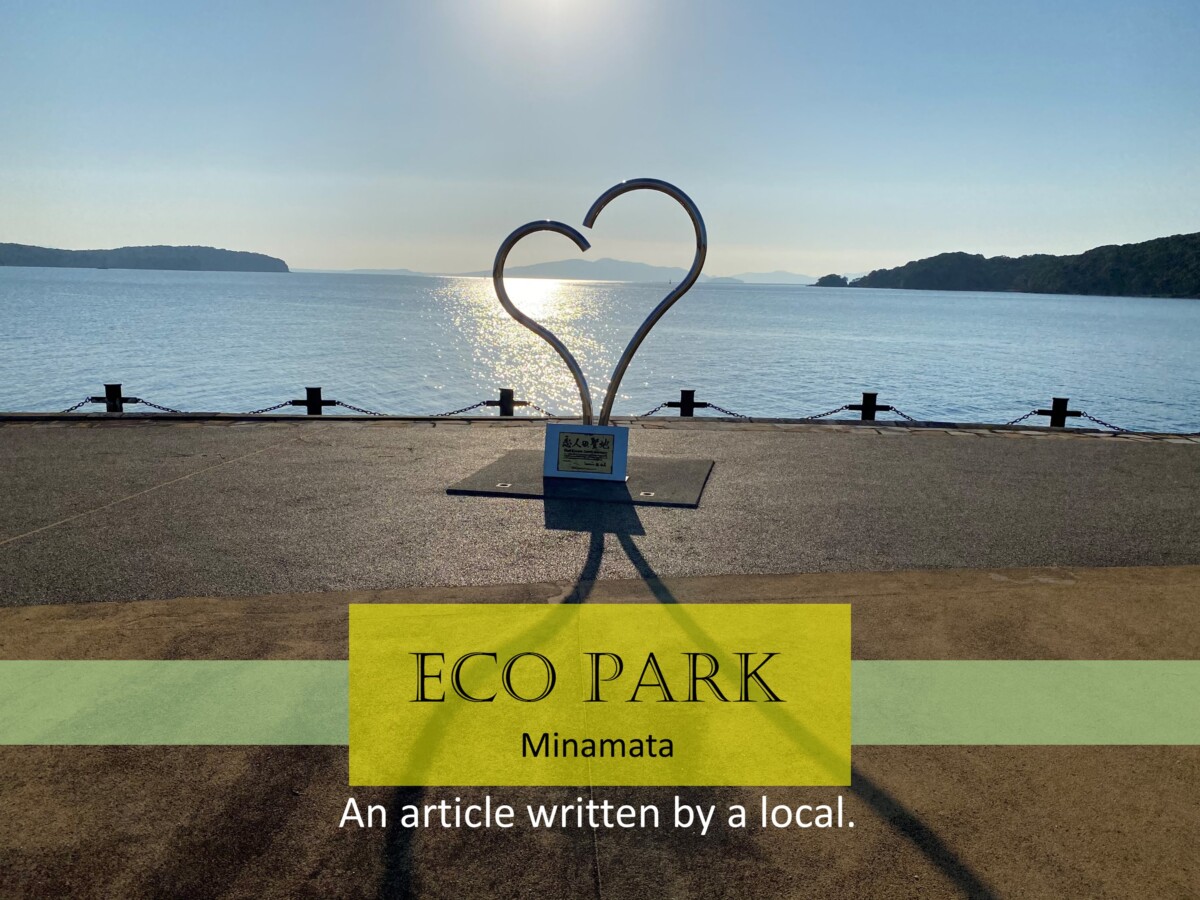
エコパーク/石原明子
週末や夕方のエコパークには、恋人たちが手をつなぎ、高齢のご夫妻がゆったりと散歩し、犬を連れた人が散歩し、ランニングする人、釣り糸を垂れる人が、ゆったりとした時間の中で交差している。後ろには、運動場で、子どもたちがサッカーに励み、会社のサークルの人がテニスを楽しむ。初夏にはバラ園を中心に、バラの花が咲き乱れ、秋から冬にかけては、牡蠣小屋も登場する。
鏡のように静かで、波のない優しい水面をたたえる親水護岸からは、目の前に恋路島、その先に天草諸島の御所浦や獅子島、その先に天草本島が見える。
On weekends and evenings in the eco park, lovers hold hands, elderly couples take leisurely walks. People walk their dogs, go for runs, or spend leisurely time hanging on to fishing lines. Behind the playground, children play soccer, and people in company circles play tennis. In early summer, roses bloom around the garden, and oyster huts appear from autumn to winter.
From the waterfront, which is calm like a mirror and has a gentle surface without waves, you can see Koiji Island, Goshoura and Shishijima in the Amakusa Islands, and Amakusa Honjima in front of you.
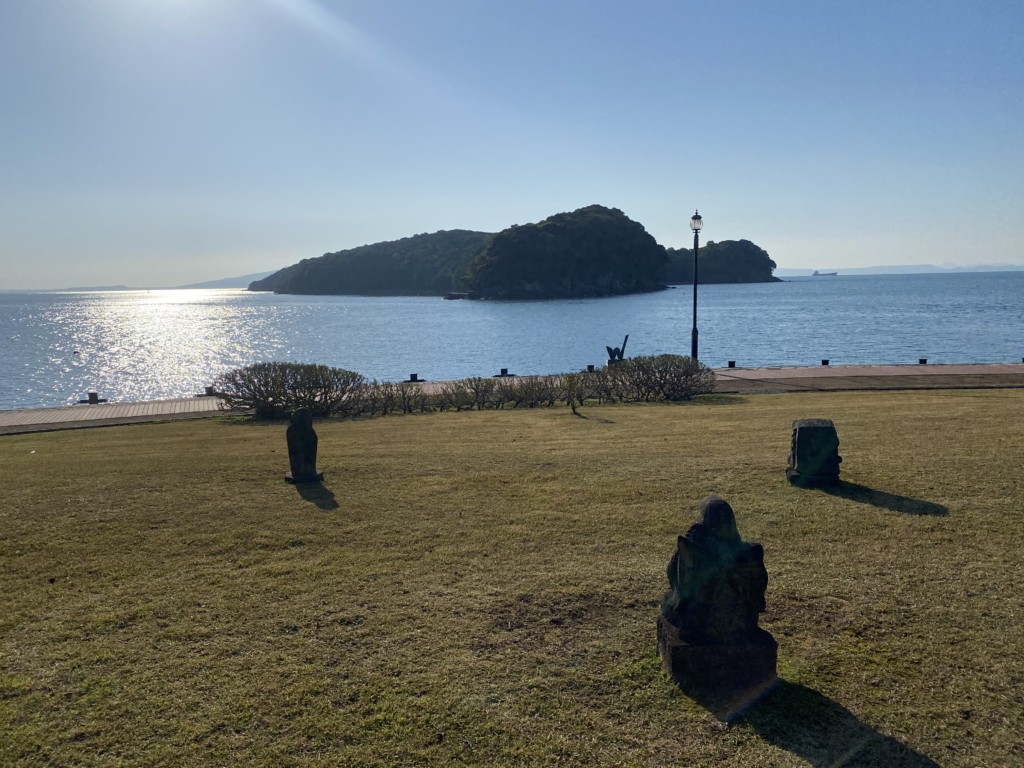
恋人たちの聖地という名もある市民の憩いの場である公園・エコパークだが、つい30数年前まではそこは海であった。天草諸島と九州本島に囲まれた内海は、荒れているという日ですらやっと波が見える程度の静かで穏やか海。たこ、エビ、アジなどが豊富に住み、人間に生命を与えてくれる「イオ湧く海(魚の湧く海)」と呼ばれてきた。
しかし近代化の中でチッソをはじめとする工場がその海岸に立ち並び、半世紀前には、水銀を含めて最も汚染された海岸となってしまった。毒でやられた魚が水面に浮く。その魚を食べた猫は狂い死に、人も水俣病となった。堆積したヘドロは4メートル以上。生命豊かな海を汚してしまった人間は、どうしようもなくなり、その毒を埋めることにした。そしてできたのがエコパークである。
人間が出した毒のヘドロで覆われた海だったが、それでも、そこには生命があった。魚がいて、タコがいた。だから、漁師やそこに住む人たちは、その自然の稜線が壊されて埋め立てられるときに、心が魂が壊され、息がつまるような思いがあったという。
Parks and eco-parks are places of recreation and relaxation for the citizens. They are also known as sacred places for lovers. The inland sea surrounded by the Amakusa Islands and the Kyushu main island is a calm sea where the waves are gentle even on rough days. The octopus and other sea creatures live in abundance and give life to humans.
However, in modern times, Chisso and other factories have lined the coast. Half a century ago this became the most polluted coast in Japan. Polluted with mercury. Poisoned fish float on the surface of the water. The cats that ate the fish died crazy, and people also suffered from Minamata disease. There is more than 4 meters of deposited sludge. The human beings who polluted the life-rich sea were buried by their own poison. Now it has become an eco park.
It was a sea covered with humans’ venomous sludge, but there was still life there. There were fish and octopus. So the fishermen and the people who lived there felt that their hearts were broken and their breath was suffocated when their natural ridges were broken and reclaimed.
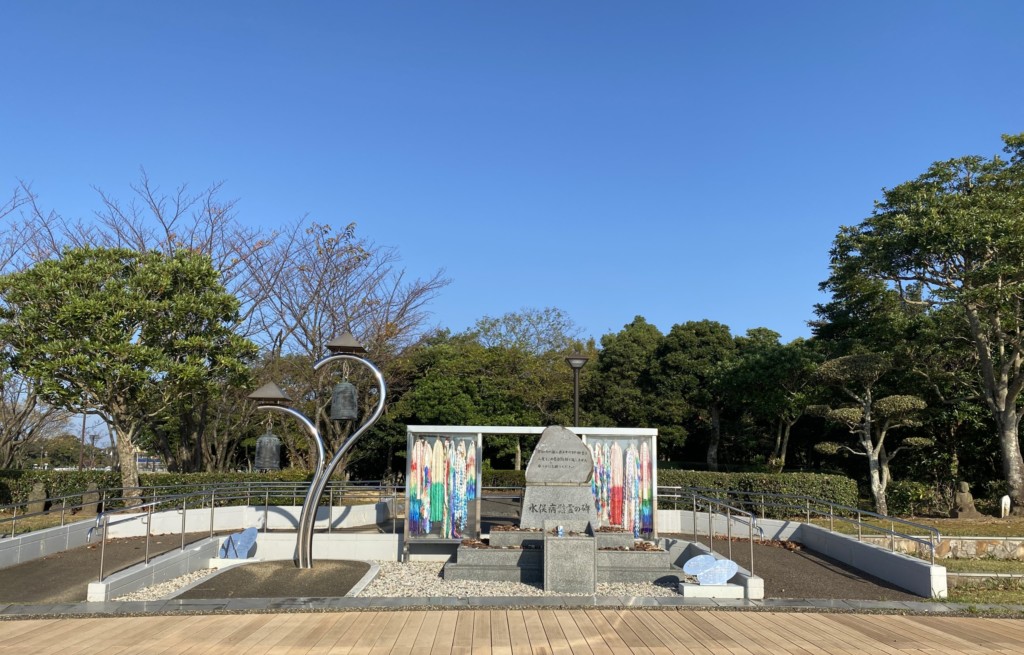
埋め立てられたその土地の下には、水銀汚染された泥とともに、3000本のドラム缶が埋められている。そのドラム缶は、人間が汚してしまった海で毒を飲んでしまった魚たちが「毒物」「汚染物」として埋められている。海が汚染された漁業ができなくなってしまった漁師さんたちは、行政から依頼され、その汚染された魚をドラム缶に入れて埋めるために、魚を獲ることを依頼され、それが収入となった時代もあるという。魚たちからどれほど生命が支えられいるかと最も肌で感じて知っている漁師たちにとって、埋めるために魚を獲るということほど、精神的にもきつい悲しい仕事はなかった。だから漁師さんたちは、エコパークは、明るい場所ではなくて「人間が殺してしまった魚たちの墓場だ」という。そこに近づこうとするだけで、魚たちの苦しみを感じて、人間の罪深さに体がけいれんして近寄れないという漁師もいた。
Under the reclaimed land, thousands of barrels were buried, along with mercury- contaminated mud. The drums were filled with “poisonous” and “contaminant” fish that had consumed poison in the sea, which was polluted by humans. At that time, fishermen who were no longer able to fish in the polluted seas were asked by the government to catch contaminated fish to fill the drums. It was a source of income. For the fishermen who knew that our life is supported by those sea creatures, there was no sadder job.
Therefore, some fishermen say that the eco park is not a bright place but a “graveyard for fish killed by humans.” Some fisherman said that they felt the fish were suffering, and the sin of humans caused their bodies to convulse just by approaching the eco-park.
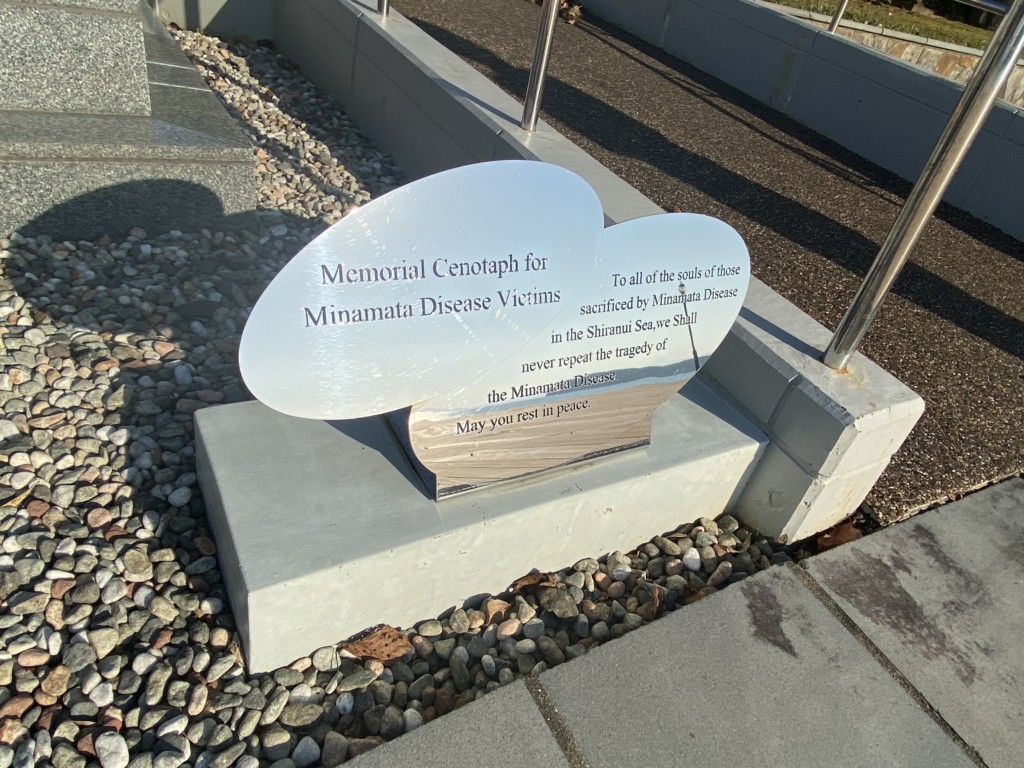
だからエコパークでは、今も「火の祭り」という水俣病によって犠牲になったあらゆる生命を慰霊する慰霊行事がある。エコパークが海に面する親水護岸の真ん中に、水俣病で犠牲になった方々の慰霊碑がある。人間のわが身の罪に、あらゆる生命に詫び、感謝して、祈りをささげて、このエコパークがある。
今、水俣で子供を育てる私にとって、エコパークは子どもを散歩させ、海の風を感じ、太陽を浴び、その静かな水面になぐさめられる大事な憩いの場だ。だけど、そこで自然に癒されるとき、その歴史への祈り、そこに眠るものへの祈りと、感謝も決して忘れないようにと思っている。でも、正直いうと、そんな「忘れないように」と思う心さえ時に忘れがちな私の罪がある。しかし、それを洗い流しゆるしてくれるほど、水俣の自然はやさしいとも感じている。私たちは、海から山からいのちをいただいている。
そんな市民の憩いの場のエコパークも、埋め立て地としての耐久年数である50年が、埋め立て工事開始時期から数えると間もなくやってくる。このままで安全なのか、この下に眠る水銀をどうするのか、熊本地震で震源がこの不知火海に来たときに、埋め立て地は割れて水銀がまた表面に現れるのではないか、ということは、現実に直面した課題である。
Therefore, there is still a memorial service called “Festival of Fire” at the Eco Park, which is a memorial service for all the lives that were lost to Minamata disease. In the middle of the waterfront seawall where the eco park faces the sea, there is a memorial monument for those victims of Minamata disease. We apologize for our sins of and pray for this ecopark.
For me, now living with a baby in Minamata, the Eco Park is an important place to relax, take a walk, feel the breeze of the sea, bathe in the sun and relax on the quiet surface of the water. But even when healed naturally, I will never forget the prayer for its history, the prayer for what sleeps there, and my thanks. But, to be honest, I feel my sin that I often forget even when I feel “don’t forget.” However, I feel that Minamata’s nature is gentle enough to wash it away. We receive life from the sea and from the mountains.
The eco-park, a place for people to relax, will soon reach its end point of 50 years from the start of its landfill construction. Whether it is safe as it is, and what to do with the mercury that sleeps beneath it, the fact that when a large earthquake comes to this Shiranui Sea, the landfill will crack and mercury will appear again on the surface is a reality. It is a that problem Minamata is facing.
Access
・熊本県水俣市汐見町1丁目231−12(Google MAP)駐車場あり
・さくらバス 市街地循環線「エコパーク道のみなまた」下車
Address: 1-231-12 shiomitown, Minamata City, Kumamoto Prefecture
Access: Get off the sakurabus “Eco park michinoeki minamata”
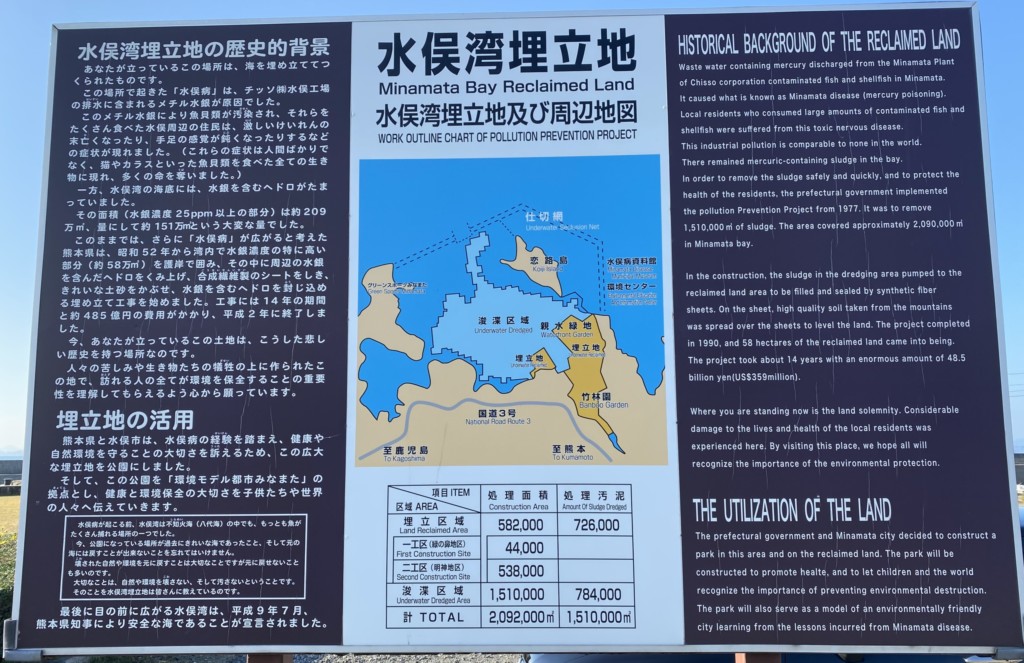
Writer Akiko Ishihara
ライター/石原明子
東京生まれ。水俣で、1歳児を育ててながら、熊本大学で教員として働く。「対立や葛藤から未来を拓く」紛争解決学が専門で、水俣や福島の人々の葛藤と再生、そこから紡がれる未来への示唆の研究をしている。
Born in Tokyo. While raising a one-year-old child in Minamata, working as a teacher at Kumamoto University.
Opening Up the Future from Conflict and Conflict, specializing in conflict resolution studies.
Researching focuses on the conflicts and rebirths of the people of Minamata and Fukushima,
and the implications for the future that can be drawn from them.
コメント ( 0 )
トラックバックは利用できません。















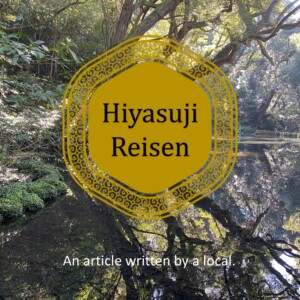
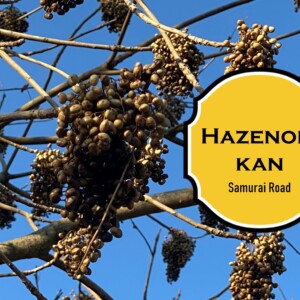
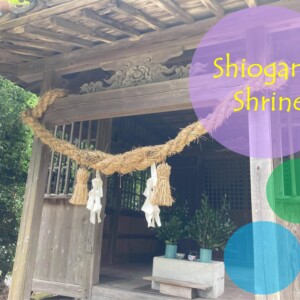

この記事へのコメントはありません。